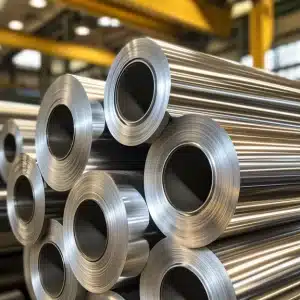
What Is Statistical Process Control Welding?
Statistical process control welding is a quality assurance approach that applies statistical techniques to monitor and control welding processes. Originally developed in the early 20th century by Walter A. Shewhart, statistical process control (SPC) has been widely adopted in manufacturing to detect variations before they result in defects. In the context of welding, statistical process control welding enables fabricators to achieve consistent, code-compliant weld quality across different batches, shifts, and operators. By integrating SPC into welding operations, manufacturers can significantly reduce variability, improve efficiency, and maintain high standards of quality and compliance.
How SPC Is Applied in Welding Environments
In statistical process control welding, key variables like voltage, amperage, travel speed, and material temperature are monitored continuously or at scheduled intervals. The collected data is plotted on charts, allowing welding teams to see trends and identify process shifts before they result in out-of-spec welds. By applying SPC to welding operations, manufacturers can better understand process behavior and take corrective action early.
Importance of Controlling Variation in Weld Quality
Every weld has natural variability, but when variation goes beyond acceptable limits, quality suffers. SPC helps define what “normal” variation looks like, and flags when deviations signal a potential issue. This allows for a proactive approach to weld quality, helping prevent defects, reduce rework, and maintain compliance with industry standards like ASME or API.
Key SPC Tools for Welding Quality Control
Using the right tools is essential in statistical process control welding. These tools provide the visual insights and actionable data that drive decision-making.
Control Charts (X-bar, R-chart, etc.)
Control charts are the heart of SPC. In welding, X-bar charts monitor the average of measured parameters, while R-charts track the range or variability. These charts highlight whether a process is stable or trending toward failure.
Histograms, Scatter Plots, and Pareto Charts
Histograms show the frequency distribution of weld quality metrics, helping identify outliers. Scatter plots explore relationships between variables (e.g., wire feed speed vs. weld penetration). Pareto charts help prioritize quality issues based on frequency or impact.
Real-Time Data Tracking During Welding Processes
Modern statistical process control welding systems often include real-time sensors and data acquisition tools. These technologies allow operators and engineers to monitor parameters live, flagging anomalies immediately rather than post-inspection.
Using SPC for Predictive Maintenance
SPC doesn’t just catch bad welds—it can signal that a welding machine or fixture is beginning to drift out of spec. This makes it a valuable tool for predictive maintenance, minimizing downtime and extending equipment life.
Benefits of Using Statistical Process Control in Welding
Adopting statistical process control welding practices brings a wide range of benefits to fabrication teams, from cost savings to code compliance.
Improved Weld Quality and Process Consistency
SPC standardizes the welding process, reducing variability between operators and shifts. This leads to a more predictable outcome and improved weld quality overall.
Reduced Rework and Scrap Costs
By catching deviations before they become defects, SPC helps minimize the need for repairs or scrapping parts—saving time, material, and labor costs.
Early Detection of Equipment or Procedural Drift
SPC charts can show gradual trends that indicate a piece of equipment is wearing out or a parameter is drifting. Catching these issues early prevents production disruptions.
Enhanced Compliance with Industry Codes and Standards
Many industries require documented quality procedures. Statistical process control welding provides the traceability and data integrity necessary to meet ASME, AWS, or ISO standards.
Implementing SPC in a Welding Operation
While the benefits are clear, success with SPC requires thoughtful implementation and team alignment.
Setting Control Limits and Selecting Key Variables
Start by identifying which variables affect weld quality most—such as voltage, amperage, wire feed speed, or travel time. Set control limits based on historical data or specification tolerances.
Collecting and Analyzing Welding Data
Data collection can be manual or automated, but consistency is critical. Once data is collected, control charts and other visual tools should be used to track performance and drive action.
Training Welders and Supervisors on SPC Usage
Everyone involved must understand how to interpret SPC charts and respond appropriately. Training ensures that welders and supervisors can identify when a process is trending out of control and know how to adjust it safely.
Integrating SPC with Digital Monitoring Systems
Today’s digital weld monitoring systems can collect and visualize data in real time. When integrated with SPC software, these systems offer seamless process control and automated alerts—making statistical process control welding more efficient than ever.
The Value of Statistical Process Control in Welding
In today’s precision-driven manufacturing environments, statistical process control welding plays a vital role in maintaining high-quality, code-compliant welds. By identifying and managing process variation before it leads to defects, SPC helps fabrication teams produce more consistent results while reducing waste, rework, and downtime.
Whether you’re fabricating pressure vessels, structural components, or critical infrastructure, integrating SPC into your welding operation empowers your team to take a proactive approach to quality control. With the right tools, training, and systems in place, SPC becomes more than a quality assurance tool—it becomes a foundation for continuous improvement.
At Red River, we believe that great welding starts with great process control—and we’re proud to support American-made projects with trusted, transparent, and technically sound practices.
Need a reliable partner?
Red River specializes in the design and manufacturing of pressure vessels. We also fabricate related items such as prefabricated spools and skid packages.
Reach out to us today and experience the Red River difference. Where American-made products and American Values come together, we care more.
Frequently Asked Questions
1. What is statistical process control in welding?
SPC in welding is a method of using statistical tools to monitor and control the welding process, ensuring consistent quality and minimizing variation.
2. Why is SPC important in welding operations?
It helps detect small process changes before they become major defects, reducing rework and ensuring welds meet code requirements.
3. What are control charts used for in welding?
Control charts monitor process variation over time, helping identify trends or deviations that could lead to weld failures.
4. Can SPC reduce welding defects?
Yes. By analyzing real-time data and controlling process variables, SPC minimizes errors and improves first-pass yield rates.
5. What types of welding benefit most from SPC?
SPC is beneficial for high-volume or code-critical welds such as those in pressure vessel, pipeline, and structural fabrication.
6. How is SPC data collected during welding?
Data can be manually recorded or captured through automated sensors tracking temperature, voltage, current, and other critical variables.
7. Is training required to implement SPC?
Yes, effective use of SPC requires training for operators and supervisors in both statistical methods and process awareness.
Key Takeaways
- Statistical process control welding improves weld consistency, reduces waste, and enhances code compliance.
- SPC tools like control charts allow teams to detect process shifts early, preventing defects.
- Implementation requires collecting meaningful data, training personnel, and using the right analytical tools.
SPC is a proactive quality control strategy—not just a way to catch bad welds, but a means to prevent them entirely.
Related Blog Post

Marine-Grade vs Standard Stainless Steel

Pros and Cons of Vertical Integration

How to Dry Desiccant Properly and Regain Its Effectiveness

Why Do Gas Turbines Need Fuel Water Separator Vessels, Red River

How Does a Gas Turbine Fuel Water Separator Vessel Work
- Vessel Weld Radiographic Inspection Procedures
- Magnetic Testing Pressure Vessels: Ensuring Structural Integrity
- Acoustic Emission Monitoring During Pressure Tests
- Phased-Array Ultrasonic Testing for Weld Inspection
- HAZ Hardness Profile Mapping in Welded Components
- Dye Penetrant Inspection (DPI) for Surface Crack Detection
